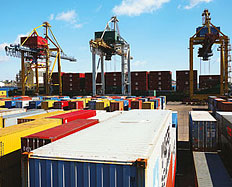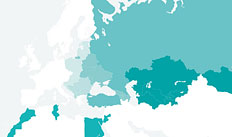Chapter 2
Outlook and risks
The euro area crisis will continue to negatively impact growth in the transition region in the near future. The eurozone will most likely progress slowly and unevenly towards containment of the crisis and record a mild recession in 2012 and no growth in 2013. Real activity in the eurozone will suffer in the near term both due to fiscal contraction and credit decline although a full scale credit crunch should be avoided. This will continue to bear on the transition region’s exports to and investments from the eurozone as well as on availability of finance for the region’s banks and therefore credit growth.
In these conditions, GDP growth in the transition region is expected to slow down substantially to 2.7 per cent in 2012 and 3.2 per cent in 2013 from 4.6 per cent in 2011. Growth in countries that are the most integrated with the euro area, including many in the CEB and SEE regions, will decelerate substantially relative to 2011. Recessions in Croatia, Hungary and Slovenia will further deepen, but even the normally resilient Polish economy is now expected to grow less. The EEC region will see slower growth mainly due to the substantially weaker Ukrainian economy, where idiosyncratic factors will combine with the weak external environment of a eurozone recession and slowing growth in Russia.
Growth elsewhere in the region will also decelerate relative to 2011 as the protracted eurozone crisis is now affecting commodity prices and investor risk aversion. Weaker demand from the euro area is impacting growth across emerging markets, depressing global commodity demand. This limits commodity prices, which in turn directly affects growth in Russia and other commodity exporters. Continued capital flight from Russia, partly due to higher investor risk aversion, further weakens domestic demand and particularly investment. Growth in Russia is projected to slow down from over 4 per cent last year to 3.2 per cent this year and only 3.3 per cent in 2013. Elsewhere, Turkey will likely avoid a possible hard landing following its capital inflow‑fuelled credit boom and Egypt’s growth should improve after a period of political instability.
The eurozone crisis poses further downside risks to the outlook, as any worsening beyond the baseline assumption of a slow progress towards crisis resolution could have serious negative consequences for growth across the entire transition region. In a downside external scenario the eurozone troubles could become much worse before they are ultimately resolved. In particular, the crisis might not be contained before spreading to larger single currency area members, which would imply prolonged market turmoil and a severe western European recession with swift negative spill-overs for the global economy. This would result in lower growth in advanced and emerging economies and lower commodity prices. A negative eurozone crisis scenario would affect CEB and SEE countries and Ukraine via the same channels as in the baseline, including depressed exports and financing inflows, only more severely. Substantially lower commodity prices in the downside scenario would also cause a severe slowdown in Russia and other EEC and Central Asian commodity exporters. The weaker Russian economy would in turn seriously impact its non-commodity exporting neighbours. The probability of this downside scenario has reduced somewhat following the recent launch of the permanent European Stability Mechanism but especially the ECB’s decision to support sovereign debt markets in the eurozone through Outright Monetary Transactions conditional on EU-supported stabilisation programmes in the countries concerned. The implementation of such a programme in Spain and consistent progress toward a banking union would further reduce the probability of this scenario.







